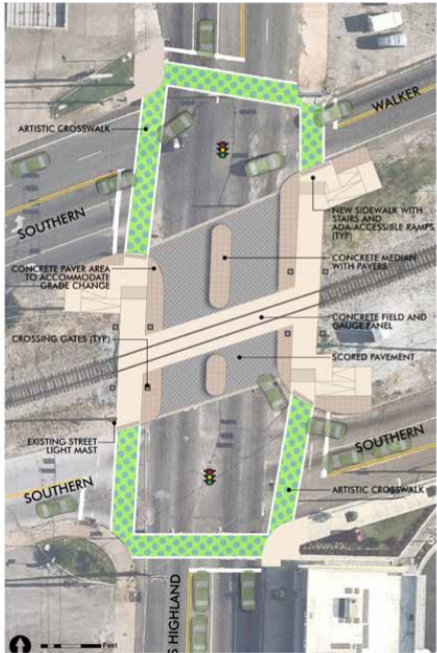 University Neighborhoods Development Corporation
University Neighborhoods Development Corporation
Works has begun and will continue in the University District to make it more walkable with slower car traffic and more police cameras to ”discourage and decrease criminal activity” in the area.
The intersection of Walker and Highland will soon have a new crosswalk, thanks to funds from the Highland Revitalization tax increment finance deal approved for the district in 2016. Officials expect the deal to generate $21 million for the district over the next 20 years.
 University Neighborhoods Development Corporation
University Neighborhoods Development Corporation
The new crosswalk will have LED signage, reconfigured sidewalks, large planters, new median features, and a painted ground mural, according to a Friday newsletter from the University Neighborhoods Development Corporation (UNDC).
“Improving pedestrian safety and access to businesses is the primary goal for this project,” reads the letter form UNDC. “Its expected to slow vehicle traffic, while allowing for greater walkability and ease of crossing Highland Street on foot.“
The UNDC recently hired local planning and design firm Looney Ricks Kiss to “re-imagine” the Highland Strip from Midland to Kearney, with a focus on streetscapes and traffic.
 University Neighborhoods Development Corporation
University Neighborhoods Development Corporation
The study includes, “parking and traffic studies, access management, opportunities for better parking solutions, utility relocation, railroad quiet zones, and ways to slow traffic to promote business success.” The study is expected to be finished next month.
 University Neighborhoods Development Corporation
University Neighborhoods Development Corporation
Last month, work began to install 27 SkyCop cameras and license plate readers in eight locations in the district.
Here’s where the police cameras are located:
• intersection of Highland and Midland
• intersection of Highland and Mynders
• intersection of Highland and Walker
• intersection of Highland and Southern
• mid-block Walker
• intersection of Walker and Brister
• intersection of Mynders and Brister
The license plate readers are at:
• intersection of Highland and Midland
• intersection of Highland and Southern
The plate readers are to “capture all vehicle traffic passing through the area.”
“The cameras are positioned to discourage and decrease criminal activity in the Highland Strip and Walker Avenue business districts, as well as near the new student housing developments just east of Highland,” says the UNDC. “Future phases will expand the network deeper into the University District.”
And remember Spin Street? The atrium of former record store at the corner of Highland and Poplar was, for years, the home to an enormous picture of Elvis Presley in gold lamé. The store closed in 2017 and Elvis has been missing from the corner for awhile.
But the UNDC partnered with the University of Memphis and Poplar Plaza for a brand new installation. Check it out:
 University Neighborhoods Development Corporation
University Neighborhoods Development Corporation
